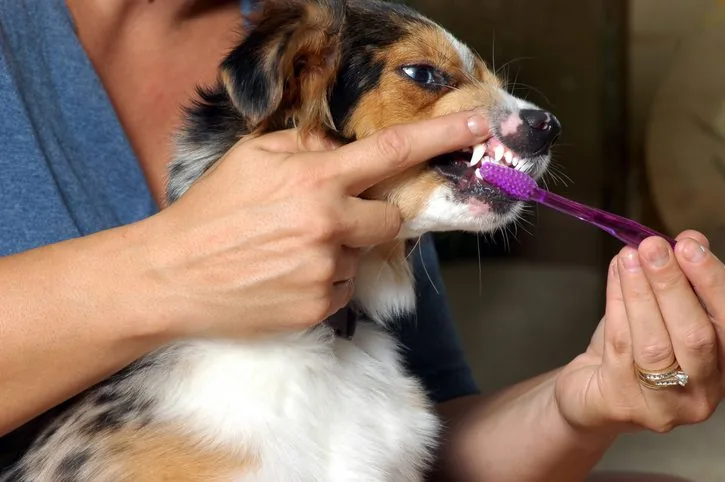Keep Your Dog’s Teeth Clean with These 6 Tips in Chicago, IL

Keeping your dog’s teeth clean along with oral hygiene is another aspect of your dog’s health that’s as equally important as a healthy diet and regular preventative exam with your veterinarian. According to the American Veterinary Dental College (AVDC), many dogs show signs of periodontal disease by the age of three. Periodontal, or gum disease, is an infection of the tissues that hold the teeth in place. The first sign of periodontal disease is bad breath, which often goes unnoticed by owners because we expect dogs to have bad breath.

How To Know If Your Dog Needs A Dental Assessment and Treatment
It’s always important to have preventative exams with your veterinarian. Between vet visits, be sure to check your dog for the following:
- Difficulty eating
- Bad breath
- Swollen and/or bleeding gums
- Excessive drooling
- Red or inflamed gums
- Tartar deposits on the teeth and along the gum line
If you notice any of these signs in your dog, contact your veterinarian. A dental assessment and treatment might be recommended. Most dental procedures begin with an assessment that involves blood work to determine if your dog is healthy enough to undergo anesthesia, and if everything is well with your pet, your veterinarian will conduct a complete oral exam and x-rays to identify problems under the gum line, a full dental treatment to prevent periodontal disease, professional scaling to remove plaque and tartar build-up, and finally polishing the teeth to prevent plaque and bacteria build-up.
Call 312-421-2275 to talk with your veterinarian at West Loop Veterinary Care about your dog’s dental assessment and treatment today!
The Why
Periodontal disease can cause some serious health issues for your best friend, so it’s essential to maintain healthy oral hygiene. Just like humans, dogs experience plaque build-up, which can then turn into tartar, accumulating around the gum lines and causing irritation, gum inflammation (gingivitis), bone/soft tissue loss, abscesses, and gum disease. Bacterial infection can also lead to tooth loss and complications of the heart, lung, or kidney as your dog ages. The good news is that, with regular dental care, these diseases are preventable. Below are listed some ways to keep your dog’s mouth healthy and happy.
Ways to Keep a Dog’s Mouth Healthy
1. Brush Your Dog’s Teeth
One of the best ways to keep your dog’s mouth healthy is to brush its teeth. It may sound strange, but it’s an excellent way to prevent tartar and plaque buildup. You don’t necessarily need to brush your dog’s teeth daily, although the more often the better. Most dogs aren’t too fond of the idea at first, but you can easily train your dog to have his teeth brushed. There are many dental products available, and it’s important to buy toothpaste made specifically for dogs because human toothpaste contains ingredients that are toxic to dogs. Dog toothpaste comes in a variety of flavors ranging from chicken or peanut butter flavor, and dogs can learn to like the flavor. Also, many canine toothpastes are enzymatic, which means that they have properties (enzymes) that help reduce bacteria, in turn limiting tartar buildup and improving bad breath. When brushing your dog’s teeth, you can use either a toothbrush made especially for dogs or a brush that fits over your fingertip. If you have any questions about brushing your dog’s teeth, ask your veterinarian for recommendations.
Training Your Dog For Teeth Brushing
There are several tips for brushing your dog’s teeth:
- First, get your dog used to the idea of having their teeth brushed. Try to keep the sessions short and non-stressful. You can acclimatize your dog to having their teeth brushed by dipping your finger in something tasty like bouillon, and massage their lips, once or twice a day for a few weeks, and then move on to the teeth and gums.
- Second, place a toothbrush along with your dog’s teeth, and gently brush in small, circular motions. Try to brush vertically toward the inside of the mouth to clear any plaque.
- Always use a toothbrush designed especially for dogs because it’s smaller than a human toothbrush and has softer bristles. Toothbrushes that you can wear over your finger can also be used.
- Always use toothpaste designed specifically for dogs, never use human toothpaste.
2. Dog Dental Wipes
If brushing your dog’s teeth isn’t an option, you may want to try dental wipes. Tooth wipes are designed to be rubbed against your dog’s teeth to help remove plaque and tartar. Wipes work similarly to toothbrushes, but unlike tooth brushing, wipes can’t get into the tiny nooks and crannies that a brush can. But, dental wipes are a great way to clean your pet’s teeth and are easier to manage than a toothbrush with toothpaste.
3. Dog Dental Treats
Dogs love treats, and dental treats a very good way to maintain your dog’s dental health. Dental treats are made to remove plaque buildup, and they contain ingredients that freshen your dog’s breath and can break up plaque ad tartar. Dental chews and treats come in a variety of shapes, sizes, and flavors, and it should be easy to find a treat that your dog likes.
4. Dog Dental Chews
There is a variety of dental chews available, and almost all of them have teeth-cleaning properties. The act of chewing benefits your dog’s oral health, no matter what your dog is chewing on. The act of chewing and gnawing scrapes plaque off your dog’s teeth, and a lot of dental chews contain enzymes that help promote dental health. If you need recommendations regarding which dental chews are best, contact your veterinarian.
5. Dog Dental Diets
Specifically formulated dental dog foods and treats can slow the build-up of tartar and avoid the progression of dental disease. Formulated veterinary dental diets provide balanced nutrition along with attributes that allow for scrubbing the teeth, freshening the breath, and reducing plaque and tartar formation. If you have questions about specially formulated dental diets for your dog, contact your veterinarian.
6. Veterinary Dental Assessment and Treatment
Perhaps the best way to ensure your dog’s oral health is to have them undergo a dental assessment and treatment by a veterinarian. Your veterinarian knows what’s best for your dog’s teeth and will be able to address any issues they find. Although dental procedures for dogs involve general anesthesia and are more expensive than the options listed above, it is the best way to maintain your dog’s optimal dental health. Your veterinarian is experienced in dental prophylaxis, and dental treatment can prevent, locate, and treat any issues that might go unnoticed. Call 312-421-2275 to talk with your veterinarian at West Loop Veterinary Care about your dog’s dental assessment and treatment today!
West Loop:
(312) 421-2275
Streeterville:
(312) 766-5959
